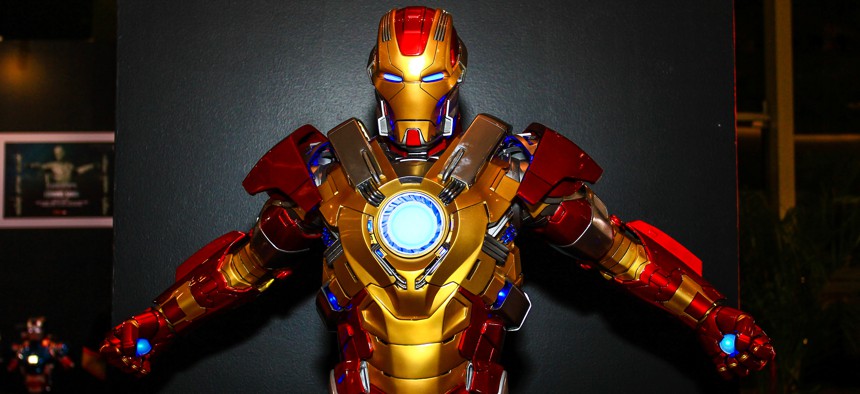
REDXIII / Shutterstock.com
The U.S. Military Is Chopping Up Its Iron Man Suit For Parts
Special Operations Command’s much-anticipated super suit won’t be here for Christmas.
When Adm. William McRaven announced in May 2013 that the military would create a next-generation, bulletproof super suit for elite soldiers, the effort immediately became an object of hype, speculation, and skepticism. The Tactical Assault Light Operator Suit, or TALOS, project—more popularly known as Iron Man—sounded like it came from a Stan Lee fever dream. It was meant to endow its wearer with enhanced tactical awareness and the physical strength and endurance of motor and metal, thanks to computerized, networked helmets and, in particular, a futuristic exoskeleton the soldier would wear beneath light, impenetrable body-armor. And for years, officials with United States Special Operations Command, or SOCOM, which McRaven led, promised that they were making progress. The dwarves of Svartalfheim, so to speak, were perfecting their offering in anticipation of much-delayed reveal.
On Wednesday, James Smith, SOCOM’s acquisition executive, announced that the final product would not match the sales pitch. In fact, the bits and pieces of the project would not come together to form a comic-book-like super suit.
“It’s not the Iron Man. I’ll be the first person to tell you that,” Smith told the crowd at the NDIA SO/LIC forum. The exoskeleton is “not ready for primetime in a close-combat environment.”
In a eulogy of sorts, Smith said the project had helped SOCOM develop partnerships with new industry players and brought about real improvements in lightweight body armor and situational awareness in helmet displays. But these partial breakthroughs weren’t enough to produce the suit everyone was waiting for.
“Admiral McRaven’s original goal [was] based on an operator going through a door for a hostage rescue, being shot in a place where his body armor plate could not save him,” he said.
Smith acknowledged that SOCOM had pushed the image for a science-fictional supersuit, as evinced by this promotional video.
“We were very public in our glossy drawings with what we thought it might look like,” he said, describing the reaction from Congress as dubious. They felt the technology was “out of reach.”
That’s where it remains.
“When we get the exoskeleton here in a few months, we will have the best exoskeleton in the Department of Defense. It will not be something our operators will feel comfortable putting on a close [combat] environment today. So, moving, shooting, communicating in the face of enemy fire, not quite there yet,” he said.
What soldiers will get instead, if they want it, is a lower-body booster that is meant to make running and long marches easier. But they’ll strip it off before the ass-kicking begins. “It could have great applicability for logistics, road march, moving long distances. We’ve got some lower leg exoskeleton components that the operators...are extremely excited about, that really reduce their burden.”
Load-reducing exoskeleton components, such as Lockheed Martin’s ONYX and FORTIS, are important innovations, with which the military community is already somewhat familiar. Said Smith, these sorts of smaller systems really will play an important role in future missions, just not the role that was promised in SOCOM’s glitzy promotional material. “I have one operator that ran a four-minute mile. I forget how many miles but it was more than one,” in one such, scaled-down exoskeleton, he said. “This operator could not do a 4-minute mile before that.”
But during an actual raid, the operator would “shed those as they prepare to go through the door, if that makes sense to you all. It certainly makes sense to the operators,” he said.
Power remains the obstacle to realizing the more elaborate, brochure-ready suits. It’s always been the case. A Center for New American Security analysis of future exoskeletons published in October observed: “The current state of technology still does not have sufficient power to manage the intense load-carrying capacity that the SOCOM TALOS suit concept requires, covering a user in hard armor, for extended dismounted infantry operations. Further research and development is needed before full-body exoskeletons will be feasible for infantry combat away from a reliable power source.”
It’s no wonder Stan Lee had to invent a power-source that defied the laws of physics to make Iron Man feasible even as a comic-book.
In the meantime, Smith says that the TALOS effort—not technically a program—produced good leads that SOCOM will to follow. “We’re not going to stop looking for better body armor, better situational awareness, better lethality. We’re going to keep looking at all of those things,” he said.
Just don’t expect any more cartoon promos.







